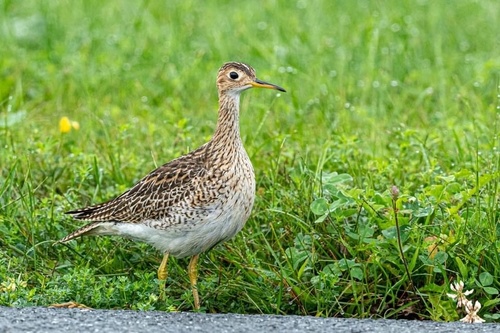
Upland Sandpiper
The Upland Sandpiper (*Bartramia longicauda*) is a unique shorebird, more often found in grasslands and prairies than coastal areas, distinguishing it from many of its relatives. It plays a crucial role in controlling insect populations within its grassland ecosystems. This bird is known for its distinctive, haunting call, often described as a 'wolf whistle,' which is a characteristic sound of the open prairies during breeding season. Historically, the Upland Sandpiper was heavily hunted, but populations have somewhat rebounded due to conservation efforts, though habitat loss remains a significant threat.
28-32 cm
Length
66-70 cm
Wingspan
Least Concern
Conservation Status
Distribution
Breeds across North America, from Alaska and Yukon south to Oklahoma and east to the northeastern United States. Winters primarily in South America, particularly in the Pampas of Argentina, Uruguay, and southern Brazil. Migrates through Central America and the Caribbean.
Lifespan
Typically 4-8 years in the wild.
Upland Sandpiper's Habitat
Habitat Types
Grasslands, Prairies, Pastures, Savannas, Airfields
Climate Zones
Temperate, Subarctic (during breeding), Tropical (during wintering)
Adaptations
Prefers areas with moderate to tall grass cover for nesting and foraging, but also utilizes shorter grass areas for feeding. Its mottled brown plumage provides excellent camouflage in grassland environments.
Variations
No recognized subspecies.
Appearance
Breeding Plumage
Plumage is relatively consistent year-round.
Seasonal Feather Changes
Slight wear may be noticeable, with breeding plumage appearing slightly brighter.
Sex Based Plumage Differences
Males and females have similar plumage.
Notable Features
Long, slender neck, Small, dovelike head, Long tail extending beyond wingtips when perched, Mottled brown and buff upperparts, Pale underparts with dark streaking on breast and flanks
Diet and Feeding
Primary Foods
Insects (grasshoppers, crickets, beetles, weevils), Spiders, Snails, Earthworms, Seeds
Foraging Behavior
Primarily forages by walking and pecking at the ground, picking up prey from the surface or probing shallowly. Often forages in open areas with good visibility.
Specializations
No highly specialized feeding adaptations, but its long bill is well-suited for probing into soil and vegetation.
Seasonal Diet Variations
Diet shifts slightly depending on prey availability. May consume more seeds during the non-breeding season when insects are less abundant.
Behavior
Social Structure
Generally solitary or in pairs during the breeding season. May form small flocks during migration and on wintering grounds.
Communication
Distinctive 'wolf whistle' call given by males during breeding season, Various other calls, including a sharp 'kip-ip-ip' alarm call
Migration
Long-distance migrant, traveling thousands of miles between breeding and wintering grounds. Migrates both day and night, often in loose flocks.
Territorial or Group Behaviors
Males defend territories during the breeding season, engaging in aerial chases and vocalizations to deter rivals.
Conservation
Threats
Habitat loss and degradation (due to agriculture, urbanization, and fire suppression), Pesticide use (reducing insect prey), Climate change (altering grassland ecosystems)
Protection Programs
Conservation Reserve Program (CRP) in the US (providing habitat on private lands), Various state and provincial wildlife management programs
Local National Laws
Protected under the Migratory Bird Treaty Act in the US and Canada.
Population Trend
Stable
Population Estimates
Global population estimated at 750,000.
Interesting Facts
They are known for their 'broken-wing' display.
When a predator approaches the nest, adults will feign injury to lure the threat away from their young.
They often perch on fence posts or rocks.
This gives them a better vantage point for spotting prey and potential predators.
Their scientific name, *Bartramia longicauda*, honors the American naturalist William Bartram.
Bartram documented many species of plants and animals during his travels in the southeastern United States in the 18th century.
Faqs about Upland Sandpiper
Where is the best place to see an Upland Sandpiper?
Look for them in large, open grasslands and prairies during the breeding season. Airfields can also be good viewing locations.
What does an Upland Sandpiper sound like?
The male's song is a distinctive, haunting 'wolf whistle,' often described as 'whee-de-leee.'
Are Upland Sandpipers endangered?
No, they are currently listed as Least Concern by the IUCN, but habitat loss remains a threat.
Copyright @ Nature Style Limited. All Rights Reserved.
 English
English